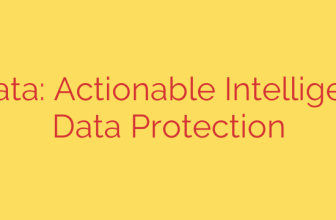
How a Single Vendor Breach Can Cripple Your Business—And How to Prevent It
In today’s interconnected digital ecosystem, your business doesn’t operate in a vacuum. You rely on a network of third-party vendors for everything from cloud hosting and payment processing to customer relationship management. While these partnerships drive efficiency and innovation, they also introduce a significant, often overlooked, risk: a security failure in your supply chain can quickly become your own business-ending disaster.
Over-reliance on a single vendor for a critical function creates a single point of failure. If that vendor experiences a data breach, a ransomware attack, or even an extended outage, the ripple effect can bring your operations to a grinding halt. This isn’t just a theoretical threat; it’s a growing reality that causes massive financial loss, reputational damage, and severe business downtime. Protecting your organization requires a proactive and strategic approach to third-party risk management.
The Hidden Danger of Vendor Dependency
When you onboard a new vendor, you are essentially extending your own security perimeter to include theirs. Their vulnerabilities become your vulnerabilities. A cybercriminal who compromises one of your suppliers may gain access to your sensitive data, your customer information, or even your internal network.
The consequences of a vendor-related breach are severe and can include:
- Operational Paralysis: If your sole payment processor goes down, you can’t process sales. If your only cloud provider has an outage, your entire platform may go offline.
- Data Exposure: A breach at a vendor holding your customer data means your data has been breached, leading to regulatory fines and loss of customer trust.
- Reputational Damage: Explaining to customers that a partner’s mistake caused their data to be leaked does little to restore confidence in your brand.
The key to survival is not eliminating vendors, but managing the inherent risks with intelligence and foresight.
Proactive Strategies to Mitigate Third-Party Risk
Waiting for a breach to happen is not a strategy. You must build a resilient operational framework that can withstand a security failure within your digital supply chain. Here are the essential steps to take.
1. Conduct Rigorous Due Diligence Before Onboarding
Your first line of defense is a thorough vetting process. Before signing any contract, you must critically assess a potential vendor’s security posture.
- Security Questionnaires: Go beyond simple yes/no questions. Ask for detailed information on their security policies, incident response plans, and data encryption standards.
- Third-Party Certifications: Look for recognized security certifications like SOC 2 Type II, ISO 27001, or FedRAMP. These demonstrate a commitment to maintaining high security standards and are verified by independent auditors.
- Reputation and History: Investigate the vendor’s track record. Have they experienced public breaches in the past? How did they respond?
2. Diversify Critical Vendors to Eliminate Single Points of Failure
Just as you wouldn’t invest your life savings in a single stock, you shouldn’t bet your entire business on a single vendor for any critical function.
- Identify Critical Functions: Map out all your business-critical operations (e.g., payment processing, cloud infrastructure, email marketing) and the vendors that support them.
- Build Redundancy: Where feasible, engage a secondary or backup vendor for these essential services. While it may increase costs slightly, this redundancy is a powerful insurance policy against an outage. For example, using multiple cloud providers or having a backup payment gateway can ensure business continuity.
3. Implement Strong Contractual Safeguards
Your contract is a powerful tool for enforcing security standards and defining liability. Do not treat it as a boilerplate document. Your legal agreements should clearly outline security expectations.
- Right-to-Audit Clauses: Insist on the right to audit your vendor’s security controls or review their third-party audit reports.
- Data Breach Notification Requirements: The contract must specify a strict timeframe for the vendor to notify you of a security incident—often within 24 to 72 hours. This allows you to activate your own response plan immediately.
- Service Level Agreements (SLAs): Define clear uptime guarantees and penalties for failing to meet them. This ensures the vendor is financially motivated to maintain a resilient service.
4. Isolate and Segment Your Network
Assume that a breach will eventually happen. Your goal is to contain the damage so that a compromise in one area doesn’t spread throughout your entire system. Network segmentation is a critical technical control that limits the “blast radius” of an attack. By creating isolated zones for different functions and vendor connections, you can prevent an attacker who breached a vendor’s access point from moving laterally into your core systems.
5. Develop and Test a Vendor-Specific Incident Response Plan
Your standard incident response plan is a good start, but it needs a dedicated chapter for third-party incidents.
- Define Communication Channels: How will you securely communicate with your vendor during a crisis? Who are the designated points of contact on both sides?
- Outline Containment Steps: What immediate actions will you take to sever connections or isolate the affected vendor if a breach is confirmed?
- Practice with Tabletop Exercises: Regularly run drills that simulate a vendor breach. This will reveal gaps in your plan and ensure your team knows exactly what to do when a real incident occurs.
Your Path to a More Resilient Business
In an interconnected world, your security is only as strong as your weakest link—and that link is often a third-party vendor. By shifting from a reactive to a proactive stance on vendor risk management, you can transform a potential liability into a secure and resilient partnership.
Start today by auditing your current vendors, identifying single points of failure, and strengthening your contractual and technical defenses. Don’t wait for a third-party breach to become your first-party disaster. Taking these decisive steps will not only protect your data and your customers but will ensure the continuity of your business in the face of an ever-evolving threat landscape.
Source: https://www.helpnetsecurity.com/2025/10/01/third-party-cyber-risk-video/








